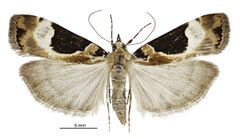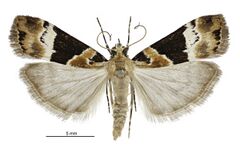Biology:Eudonia aspidota
| Eudonia aspidota | |
|---|---|

| |
| Female | |

| |
| Male | |
| Scientific classification | |
| Kingdom: | |
| Phylum: | |
| Class: | |
| Order: | |
| Family: | |
| Genus: | |
| Species: | E. aspidota
|
| Binomial name | |
| Eudonia aspidota (Meyrick, 1884)
| |
| Synonyms | |
| |
Eudonia aspidota is a moth in the family Crambidae. It is found in New Zealand.
Taxonomy
This species was first described by Edward Meyrick in 1884 and named Xeroscopa aspidota.[1][2] Meyrick added further detail when he described the species later in 1884.[3] In 1913 Meyrick placed the species within the genus Scoparia.[4]
Description
The wingspan is 22–26 mm. The forewings are light ochreous, sometimes mixed with reddish-ochreous. There is a black white-margined triangular spot on the costa. The hindwings are pale grey with a darker grey post medial and hind marginal line.[3]
Although the wing markings of this species attract attention, they also imitate bird droppings.[5] This mimicry offers protection to E. aspidota when it is not in flight.
Distribution
E. aspidota is endemic in New Zealand.[6] Meyrick stated it could be found in Wellington, Castle Hill, Mount Hutt, Dunedin and Lake Wakatipu.[3] George Hudson added to the localities where E. aspidota could be found and included Raurimu, Waimarino, Buller River, Invercargill and Stewart Island.[5] Hudson was of the opinion that the species was probably distributed throughout New Zealand.[5]
Ecology and habitat
The habitat of this species is amongst forest.[5]
Host plants
The larvae of this species lives on mosses.[7]
Occurrence
Adults of E. aspidota are normally present during December and January.[3] This species is attracted to light.[5]
References
- ↑ Meyrick, Edward (1884). "Descriptions of New Zealand Microlepidoptera. IV. Scopariadae." (in en). New Zealand Journal of Science 2: 235–237. https://biodiversitylibrary.org/page/41863308.
- ↑ , p. 458, Wikidata Q45922947
- ↑ 3.0 3.1 3.2 3.3 Meyrick, E. (1884). "Descriptions of New Zealand Micro-Lepidoptera.". Transactions and Proceedings of the New Zealand Institute 17: 68–149. https://biodiversitylibrary.org/page/33934545.
- ↑ Meyrick, E. (1913). "A revision of New Zealand Pyralidina." (in en). Transactions and Proceedings of the New Zealand Institute 45: 30–51. https://biodiversitylibrary.org/page/9975784.
- ↑ 5.0 5.1 5.2 5.3 5.4 Hudson, G. V. (1928). The Butterflies and Moths of New Zealand.. Wellington: Ferguson & Osborn Ltd.. pp. 201–202. http://www.bugz.org.nz/WebForms/ResultDetails.aspx?CurrentDoc=C7E94865-492F-45DA-9777-CC8E1E8B1438&CurrentPage=519&searchType=1&StartChar=%ufffd.
- ↑ "Eudonia aspidota (Meyrick, 1884)". Landcare Research New Zealand Ltd. http://www.nzor.org.nz/names/dee1b1ec-0f12-42cb-ab39-70b71d438b05.
- ↑ Patrick, Hamish J.H.; Bowie, Mike H.; Fox, Barry W.; Patrick, Brian H. (2011). "The moths of Quail Island (Ōtamahua): a faunal comparison of an island under restoration with other sites on Banks Peninsula.". New Zealand Natural Sciences 36: 57–72. http://www.science.canterbury.ac.nz/nzns/issues/vol36-2011/patrick.pdf. Retrieved 2017-12-17.
Wikidata ☰ Q13618174 entry

